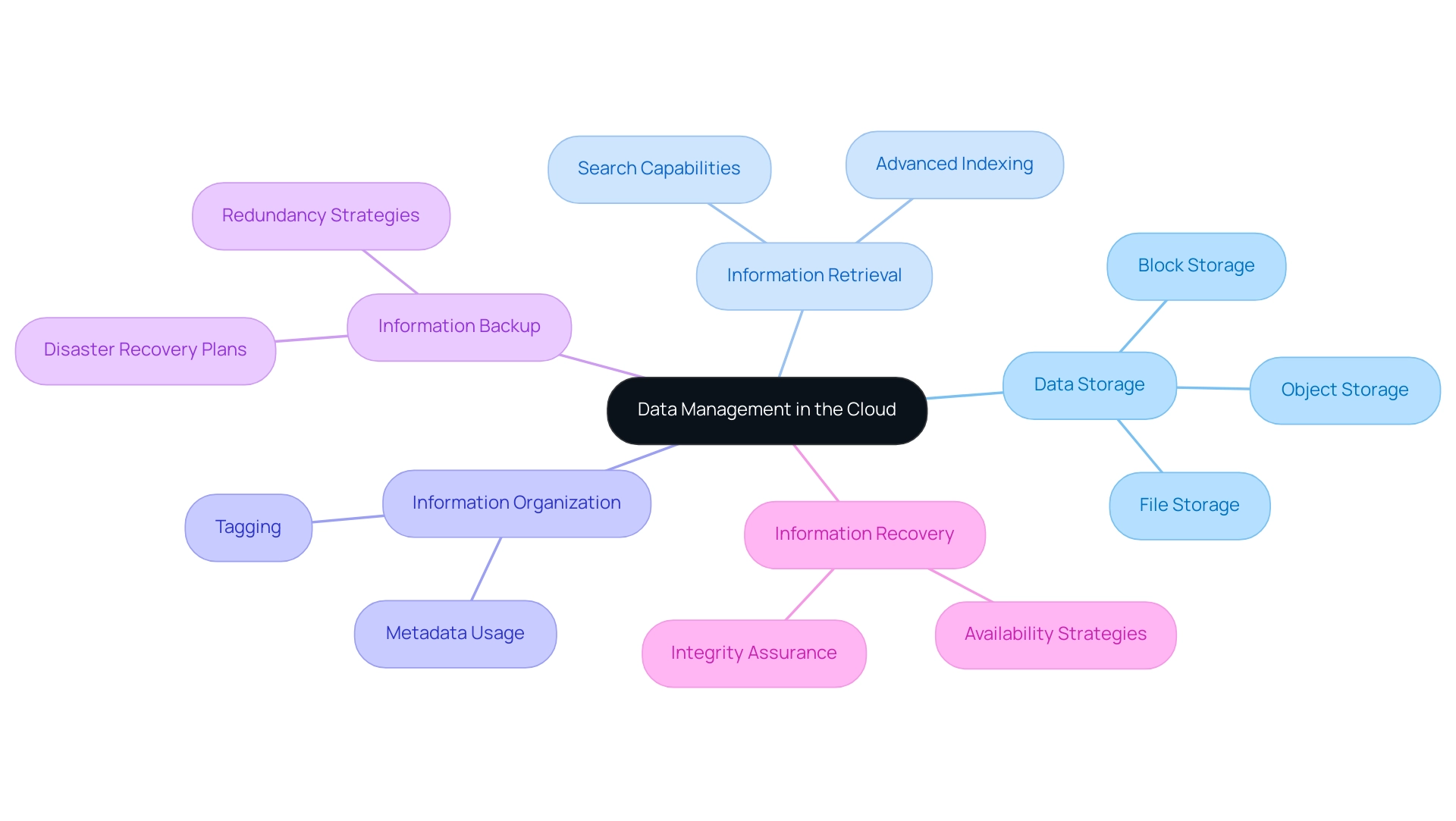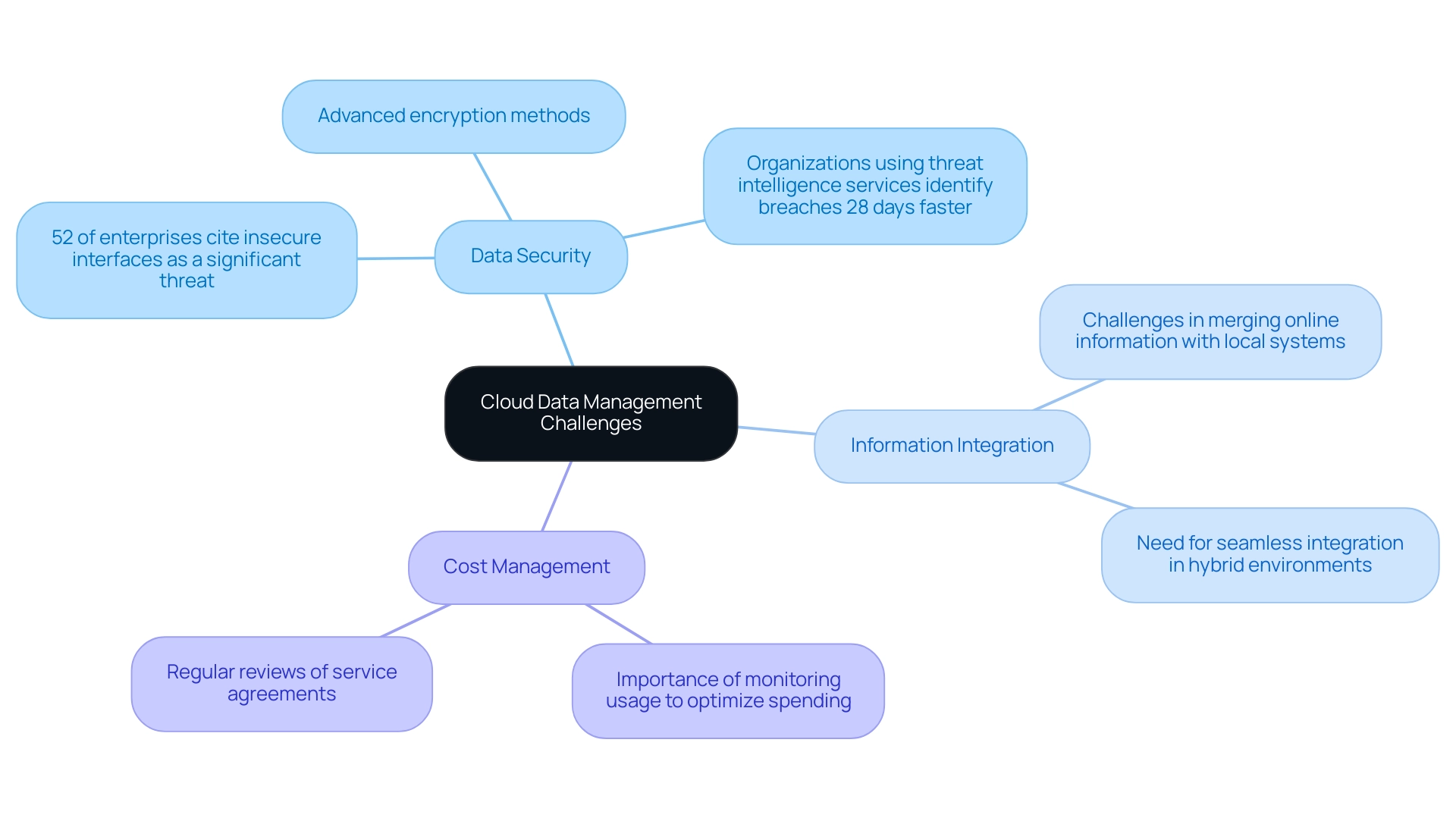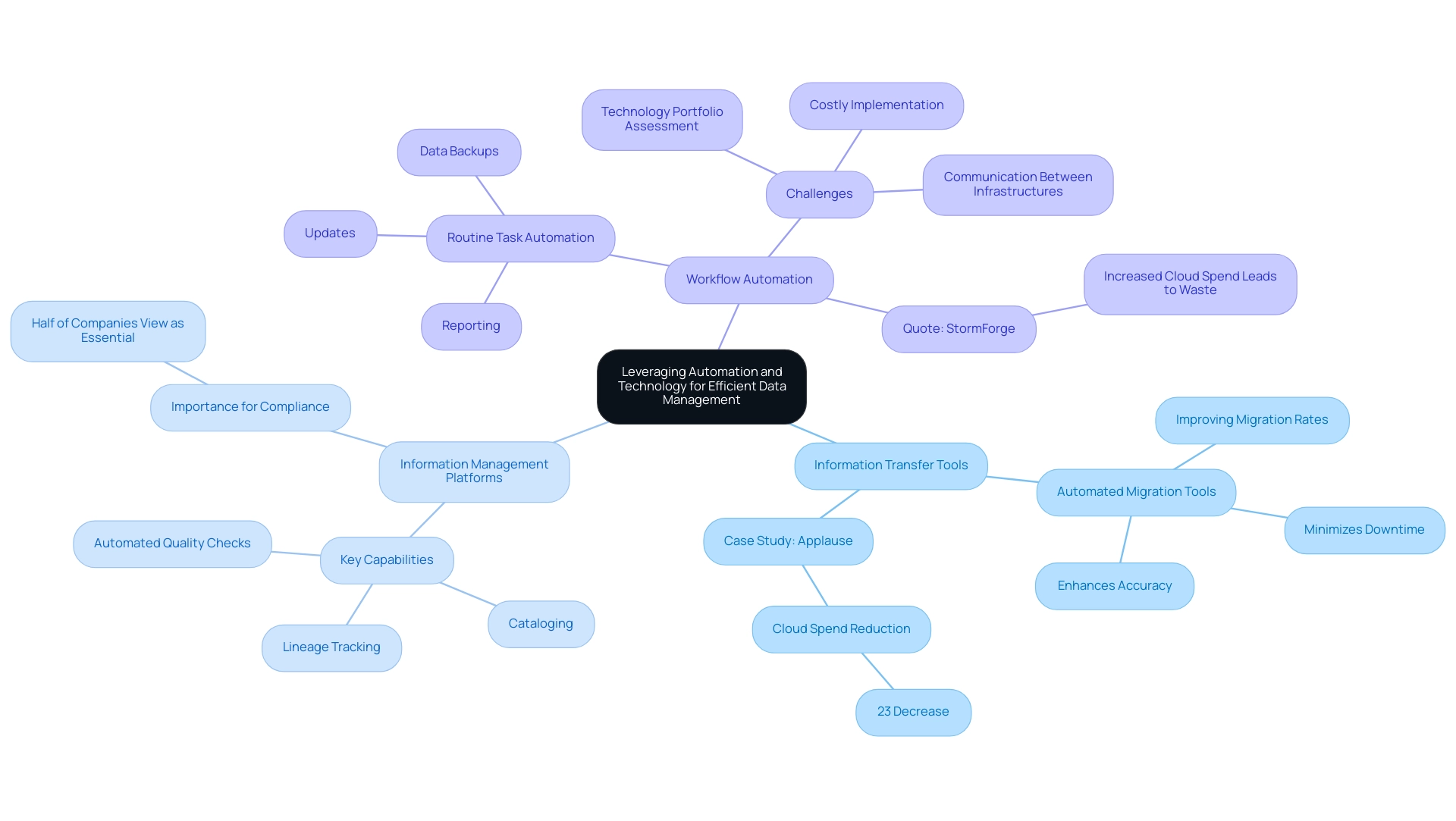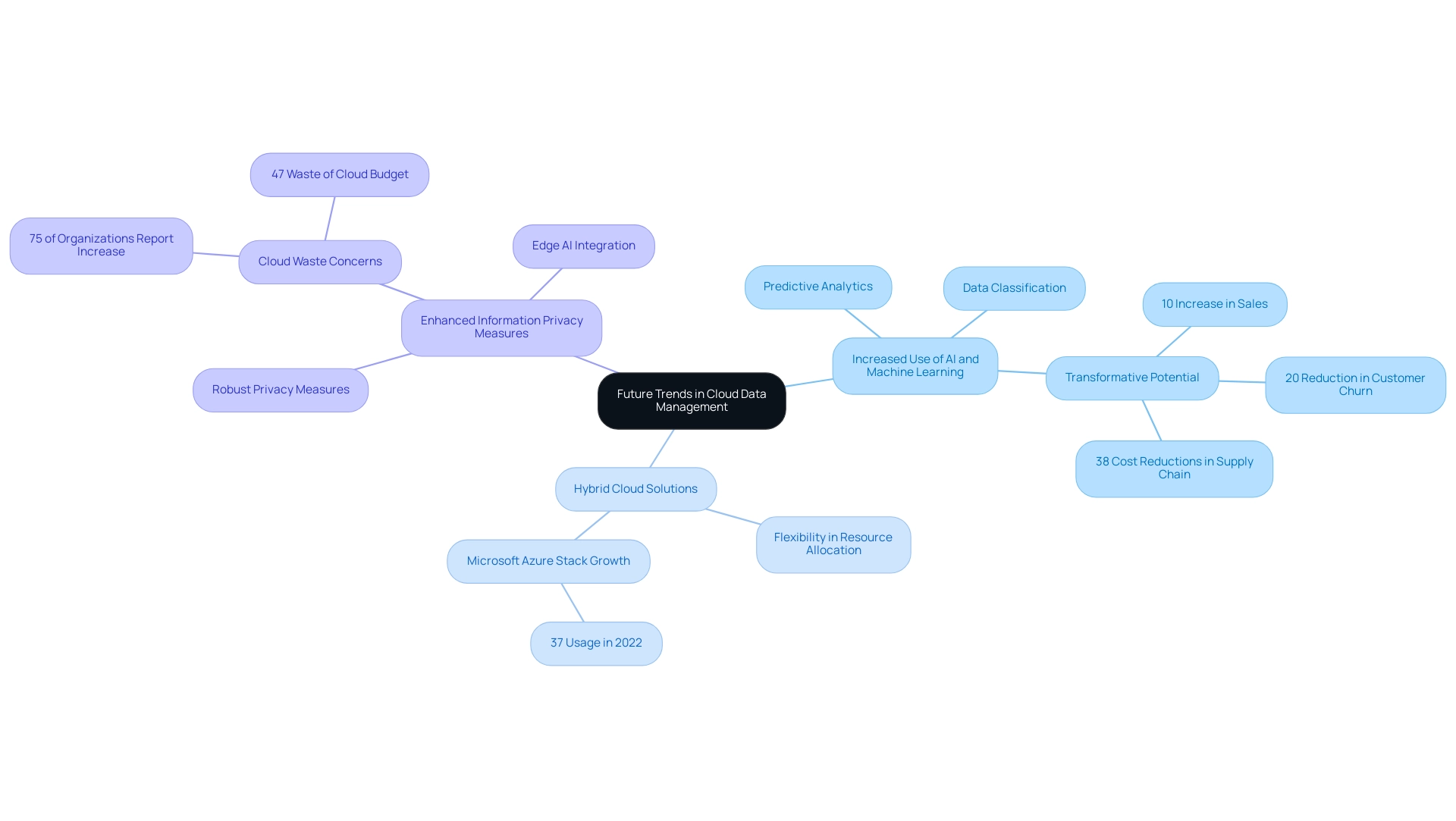Introduction
In the rapidly evolving digital landscape, effective data management in the cloud has emerged as a cornerstone of organizational success. As businesses increasingly transition to cloud-based solutions, understanding the intricacies of data storage, retrieval, organization, and security becomes paramount.
This article delves into the essential components of cloud data management, highlighting both the challenges organizations face and the best practices that can enhance operational efficiency. From leveraging automation technologies to ensuring compliance and governance, the insights presented here will equip enterprises with the knowledge needed to navigate the complexities of cloud data management and harness its full potential.
As the volume of data continues to surge, driven by an ever-expanding network of connected devices, the urgency for robust data strategies has never been greater.
Understanding Data Management in the Cloud
Efficient information management involves a range of processes and technologies aimed at allowing organizations to effectively store, organize, and retrieve their information. As enterprises increasingly migrate to cloud-based solutions, managing data in the cloud and understanding key components becomes essential.
-
Data Storage: Organizations must be well-versed in various storage options, including block storage, object storage, and file storage.
Each type serves distinct needs and use cases, impacting cost and performance. -
Information Retrieval: Employing optimal techniques for managing data in the cloud and retrieving information from cloud storage solutions is critical. This includes leveraging advanced indexing and search capabilities to streamline information access.
-
Information Organization: Structuring information effectively is paramount. Using metadata and tagging not only improves retrieval efficiency but also simplifies oversight processes, facilitating compliance with information governance standards.
-
Information Backup and Recovery: Implementing robust strategies for redundancy and disaster recovery is essential to ensure integrity and availability.
With misconfiguration of online services recognized as a primary factor in security breaches, organizations must prioritize these strategies to protect their assets.
Mastering these concepts enables organizations to establish a robust framework for resilient information handling. The digitization of life and the proliferation of connected devices have led to an exponential rise in information generation, with projections suggesting that by 2025, 50% of information will be stored remotely, contributing to a total global information volume anticipated to reach 200 zettabytes. This trend is emphasized by the case study 'Storage Trends,' which illustrates how the connectivity of devices propels information growth.
Moreover, as indicated by IBM's reported revenue increase of 20% in 2020, enterprises that adopt best practices for management will not only reduce waste—an issue pointed out by StormForge, which stated, 'Most companies reported that as their spending increased, so did their waste'—but also improve operational efficiency and decision-making based on information.

Navigating Challenges and Best Practices in Cloud Data Management
Organizations frequently encounter a range of challenges when managing data in the cloud, with the following issues being particularly prominent:
-
Data Security: The protection of sensitive data against unauthorized access and breaches remains a critical concern. Recent findings indicate that 52% of enterprises recognize insecure interfaces in public computing environments as a significant security threat, highlighting the need for robust security measures. Furthermore, organizations using threat intelligence services have been able to identify breaches 28 days faster, underscoring the effectiveness of proactive security strategies.
-
Information Integration: The intricacy of merging online information with local systems and additional online services poses significant obstacles. As enterprises increasingly adopt hybrid environments, seamless integration is essential for operational efficiency.
-
Cost Management: Effectively managing expenses related to cloud services is vital to prevent unexpected costs that can derail budgets. Organizations must maintain vigilance in monitoring usage to optimize spending.
Best Practices to address these challenges include:
- Implementing advanced encryption methods for data at rest and in transit, which not only safeguards sensitive information but also complies with regulatory requirements.
- Utilizing extensive online resource platforms that enable real-time observation and enhancement of digital assets, ensuring efficient use of resources.
- Conducting regular reviews and adjustments of service agreements to ensure alignment with evolving business needs and technological advancements. This proactive method can help reduce potential risks related to data management.
Furthermore, it is crucial to recognize that healthcare sectors are among the most targeted industries for misconfiguration breaches, representing 20%. The case study titled "Victims of Security Breaches in the Cloud" illustrates that various entities, including tech firms (41%) and healthcare providers (20%), are frequently affected, emphasizing the critical need for effective security measures.

Leveraging Automation and Technology for Efficient Data Management
Automation tools and technologies are essential for enhancing information management within online environments. Key strategies that organizations should adopt include:
-
Information Transfer Tools: Utilize automated migration tools to enable smooth transfers to the online storage. These tools not only enhance accuracy but also minimize downtime, crucial for maintaining business continuity. In fact, as we approach 2024, statistics indicate that successful information migration rates are improving, underscoring the efficacy of these tools. For example, Applause incorporated CloudZero and observed their expenditure on hosting decrease by 23%, highlighting the concrete advantages of employing automation in information handling.
-
Information Management Platforms: Implement robust information management platforms equipped with capabilities such as cataloging, lineage tracking, and automated quality checks. These attributes are crucial for maintaining information integrity and compliance, especially in a time when half of surveyed companies acknowledge online computing as essential for their protection strategies.
-
Workflow Automation: Utilize workflow automation tools to orchestrate routine tasks such as data backups, updates, and reporting. This not only enhances operational efficiency but also allows teams to redirect resources towards more strategic initiatives. StormForge emphasizes a prevalent issue; "Most companies reported that as their expenditure on online services increased, so did their waste in that area." By automating workflows, organizations can mitigate these inefficiencies and optimize resource utilization. However, it is important to be aware of the complexities involved. The case study titled "Challenges in Implementing Automation" emphasizes that implementing automation can be costly and requires careful assessment of technology portfolios, alongside maintaining communication between virtual and on-premises infrastructures.
By adopting these advanced technologies, enterprises can create a more efficient and dependable information handling framework for managing data in the cloud, ultimately enhancing their cloud computing capabilities and fostering better business results.

Ensuring Data Governance and Compliance in the Cloud
To ensure effective information governance and compliance, organizations must undertake several critical actions:
- Establish Governance Policies: It is essential to develop comprehensive policies that clearly define ownership, access controls, and the management of information throughout its lifecycle. Such clarity helps mitigate risks associated with information mismanagement.
- Conduct Regular Audits: Implementing regular compliance audits is vital for adherence to data protection regulations, including GDPR, HIPAA, and CCPA. In fact, entities conducting frequent audits are better positioned to identify compliance gaps and address them proactively, ensuring alignment with evolving regulatory standards.
- Utilize Compliance Tools: Leveraging advanced compliance tools can significantly enhance monitoring capabilities, allowing entities to track their compliance status effectively and generate the reports required by regulatory bodies. This technological integration is becoming more crucial, as 52% of compliance experts express concerns about insufficient information related to partners, highlighting the risk of third-party vulnerabilities.
- Integrate ESG Considerations: As the growing importance of ESG compliance indicates, 91% of business leaders believe their companies have a responsibility to act on ESG issues. This responsibility extends to governance of information, where organizations must consider ESG factors in their compliance frameworks to address broader organizational responsibilities.
By prioritizing robust governance, organizations can protect their information assets and foster trust with customers and stakeholders. The potential repercussions of neglecting these practices are illustrated by a study revealing that NASDAQ companies experiencing a breach saw their share prices decline by an average of 13% over three years. Moreover, as Anna Fitzgerald, a Senior Content Marketing Manager, noted,
60% of risk and compliance professionals indicate that Cybersecurity is a planned training topic over the next two-to-three years.
This highlights the increasing awareness of the necessity for continuous education in compliance and governance, mirroring the evolving environment of information oversight. Additionally, with 57% of business professionals noting that compliance roles have become more specialized, organizations must adapt to these changes to ensure effective governance.

Future Trends in Cloud Data Management
As cloud information oversight continues to progress, several key trends are emerging that deserve attention:
-
Increased Use of AI and Machine Learning: Organizations are increasingly utilizing the power of AI and machine learning to improve information handling capabilities. These technologies enable predictive analytics, data classification, and anomaly detection, allowing for more proactive and efficient data governance. A notable finding from McKinsey indicates that European banks that transitioned from traditional statistical methods to machine learning techniques experienced up to a 10% increase in sales of new products and a 20% reduction in customer churn, highlighting the transformative potential of these technologies. Furthermore, a global survey by McKinsey revealed that generative AI has significantly impacted revenue in supply chain operations, with 38% of businesses reporting cost reductions through machine learning. This underscores the critical role that AI and ML play in driving financial performance.
-
Hybrid Cloud Solutions: The shift towards hybrid cloud models is gaining momentum, offering entities the flexibility to balance on-premises and cloud resources. This approach not only optimizes resource allocation but also enhances control over managing data in the cloud. With Microsoft Azure Stack usage growing to 37% in 2022, it's clear that enterprises are increasingly adopting hybrid solutions to meet their unique operational needs.
-
Enhanced Information Privacy Measures: In response to rising concerns regarding privacy, entities are compelled to implement more robust privacy measures to safeguard customer information. The necessity for enhanced information security is highlighted by a recent report showing that 75% of firms faced a rise in waste in their online storage, with some enterprises encountering waste as high as 47% of their budget for online services. This situation emphasizes the urgency of adopting effective information handling practices that prioritize privacy and resource optimization. Additionally, the emergence of Edge AI enables streamlined AI deployment through seamless integration and orchestration of AI workflows, further enhancing capabilities for managing data in the cloud.
By remaining vigilant about these trends, organizations can strategically position themselves for success in the evolving landscape of managing data in the cloud, ensuring they are not only compliant but also competitive.

Conclusion
The landscape of cloud data management is critical for organizations aiming to thrive in an increasingly digital environment. Understanding the fundamental aspects of data storage, retrieval, organization, and security is essential for leveraging the full potential of cloud solutions. As highlighted, effective data management encompasses not only technical proficiency but also strategic foresight in addressing challenges such as data security, integration, and cost management.
Organizations must adopt best practices that prioritize robust security measures and proactive compliance strategies to mitigate risks associated with cloud data management. The integration of automation technologies further enhances operational efficiency, allowing businesses to streamline processes and reduce resource waste. Embracing advanced tools for data migration, management, and governance is crucial for maintaining data integrity and ensuring regulatory compliance.
Looking ahead, the trends of increased utilization of AI and machine learning, the rise of hybrid cloud solutions, and the emphasis on enhanced data privacy will shape the future of cloud data management. By staying informed and adaptable, organizations can navigate this dynamic landscape, ensuring they remain competitive while effectively managing their data assets.
In conclusion, as the volume of data continues to surge, the need for a comprehensive and strategic approach to cloud data management becomes increasingly vital. Organizations that prioritize these elements will not only enhance their operational capabilities but also secure their position as leaders in their respective industries.




